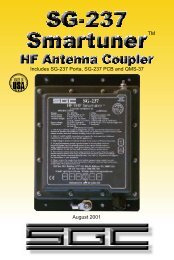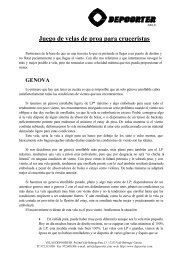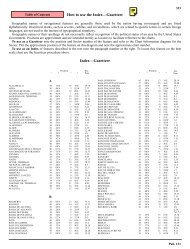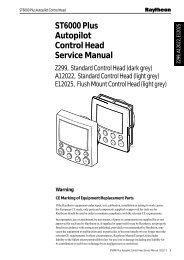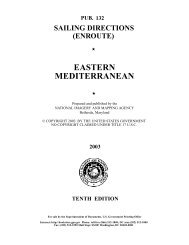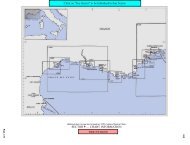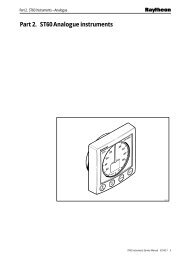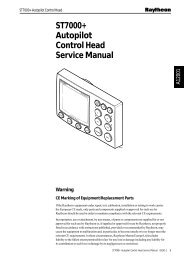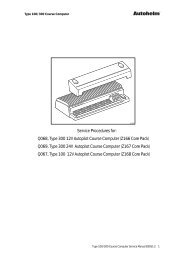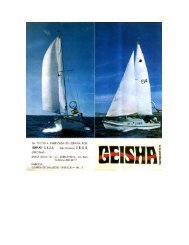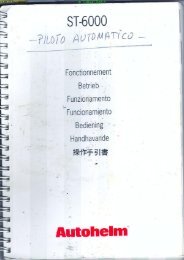Autohelm Inboard Autopilots (ST6000 and ST7000 systems) Service ...
Autohelm Inboard Autopilots (ST6000 and ST7000 systems) Service ...
Autohelm Inboard Autopilots (ST6000 and ST7000 systems) Service ...
- No tags were found...
You also want an ePaper? Increase the reach of your titles
YUMPU automatically turns print PDFs into web optimized ePapers that Google loves.
<strong>Autohelm</strong>1. Control Unit PCB Circuit descriptionFig. 4. Circuit DiagramFig. 5. PCB Assembly/Parts List1.1 Power supplyIncoming power is routed to the PCB via PL1 <strong>and</strong> SKT1. Dl <strong>and</strong> D2 protect againstreverse connection of the supply. IC1 is a 5v regulator <strong>and</strong> can also reset themicroprocessor, via TR1, should the supply voltage fall below 6V.1.2 Microprocessor <strong>and</strong> program memoryIC6 is an Intel 80C32 microprocessor. It can access up to 32k bytes of programmemory (IC5) via the latch IC4. A clock signal for the microprocessor is provided byan 11MHz ceramic resonator (XL1), <strong>and</strong> associated capacitors CIS <strong>and</strong> C16.Capacitors C17, C18 <strong>and</strong> C19 provide decoupling.1.3 LCD <strong>and</strong> Display driverThe LCD is a Nautech custom part. The display is driven by a Hitachi Led driver (IC3)deriving its drive voltages from resistor chain R27-R30 <strong>and</strong> VR1. Communication tothe microprocessor is via a 4 bit parallel bus (DB4 to DB7) <strong>and</strong> the three control linesE,R/W <strong>and</strong> RS. Capacitors C8 <strong>and</strong> C10 provide decoupling <strong>and</strong> resistor R26 theclock signal for IC3.1.4 Negative Rail GeneratorA negative voltage rail is required by the LCD display <strong>and</strong> is generated by a switchingregulator formed by TR6,D5 <strong>and</strong> D6. A 4.8kHz waveform is generated from themicroprocessor P3.4 (pin no. 16). This drives a charge pump, via transistor TR16,pumping charge from C20 via D6 to C21. The negative rail is then stabilised by D5<strong>and</strong> R49.1.5 N.M.E.A InterfaceNMEA data is fed to the control unit via PL2 <strong>and</strong> isolated from the rest of the circuitusing the opto-isolator (IC7). Diode D3 provides input reverse connection protection<strong>and</strong> resistor R15 is tuned to give the desired b<strong>and</strong>width of operation. The output fromIC7 is connected to the microprocessor Port P3.2 (pin 14). Capacitor C7 providesdecoupling.1.6 Seatalk Bus Transmit <strong>and</strong> ReceiveSeatalk transmit <strong>and</strong> receive circuitry consists of TR9, 10, 11 ,12, 13, 14 <strong>and</strong> 15 <strong>and</strong>their associated components. Data transmission is at 4800 baud with a low start bit<strong>and</strong> line idling high. TR9 <strong>and</strong> TR13 provide high <strong>and</strong> low output respectively, whilstTR14 <strong>and</strong> R45/46 give overload protection to Trl3 in the event of misconnection.TR10 <strong>and</strong> TR11 allow the microprocessor to monitor its own transmissions <strong>and</strong> alsoto receive data from other units on the bus.1.7 Keypad operationThe 10 button keypad is interfaced to the microprocessor via 2 dual input multiplexerIC's.2SeaTalk <strong>Service</strong> Manual



